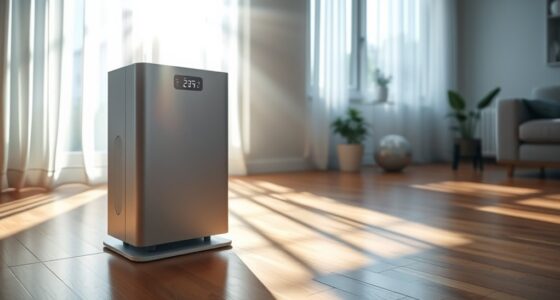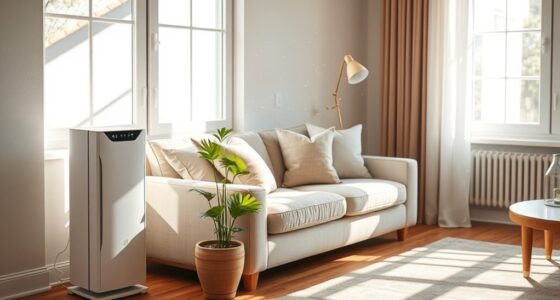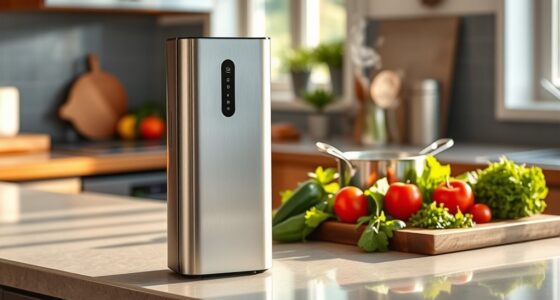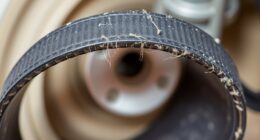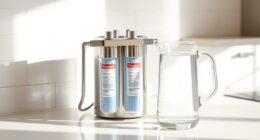Air ionizers work by generating negative ions that attach to airborne particles, causing them to clump together and settle. This helps improve air quality but may not effectively remove larger allergens, and there’s a risk of ozone production, which can irritate your lungs. While ionizers can enhance respiratory health and mood, combining them with traditional HEPA filters is often more effective. Stick around to explore more about their benefits and potential risks.
Key Takeaways
- Ionizers produce negative ions that help clump airborne particles, aiding in their removal from the air, but may not effectively reduce larger allergens.
- Negative ions can improve mood, reduce stress, and enhance respiratory health by promoting cleaner air intake and potentially boosting immune function.
- Ozone emissions from ionizers can irritate the lungs and worsen respiratory issues, making traditional HEPA filter purifiers a safer alternative.
- Combining ionizers with traditional HEPA filters can significantly enhance air quality by leveraging the strengths of both technologies.
- Regulatory bodies, like CARB, set limits on ozone emissions from ionizers, emphasizing the need for consumer awareness regarding safety and efficacy.
Understanding Air Ionizers: Mechanism and Functionality
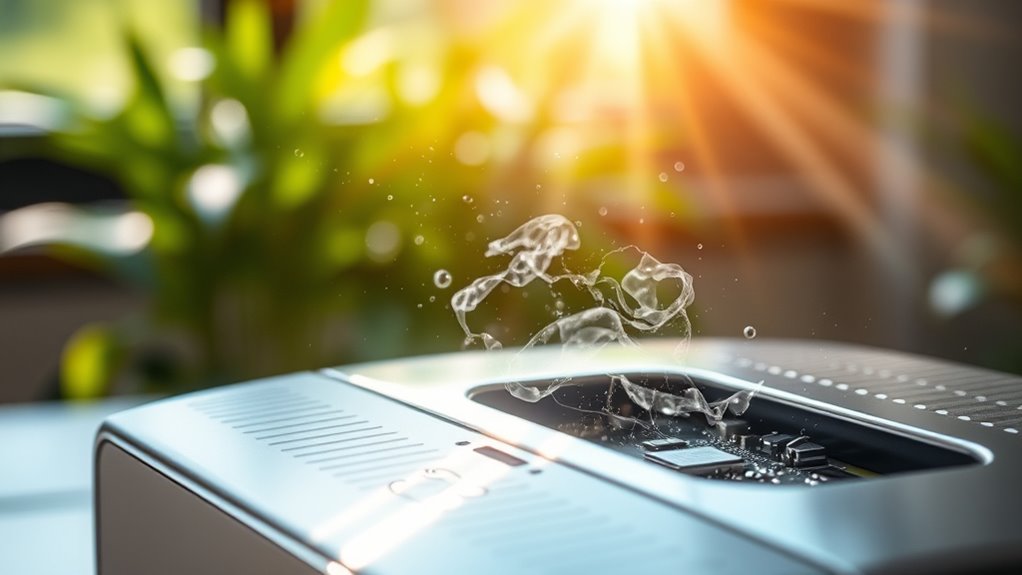
Air ionizers play an essential role in air purification by generating negative ions that attach to airborne particles. This mechanism gives the particles an electrical charge, causing them to clump together and settle on surfaces, effectively aiding in pollutant removal. Additionally, these devices can complement other filtration methods, such as HEPA filters, for a more comprehensive approach to indoor air quality. Regular use of essential oils like lavender can further enhance the atmosphere by promoting relaxation and well-being. Furthermore, air ionizers can be particularly effective when combined with UV light technology to enhance overall air quality.
While air ionizers excel at reducing small particles, they’re less effective against larger allergens like dust and pollen. It’s important to recognize that some ionizers produce ozone as a by-product, which can irritate your respiratory system and worsen conditions like asthma. Regular maintenance of air purifiers, including filter replacement, can help ensure optimal performance and air quality.
You’ll find two main types of ionizers: fanless models, which are energy-efficient and quiet, and fan-based models, which tend to be noisier and consume more energy. Understanding these aspects helps you make informed choices about air ionizers and their health effects. Additionally, regular use of air purifiers, including ionizers, can lead to improved respiratory health, alleviating symptoms of asthma and allergies.
Health Benefits of Negative Ions
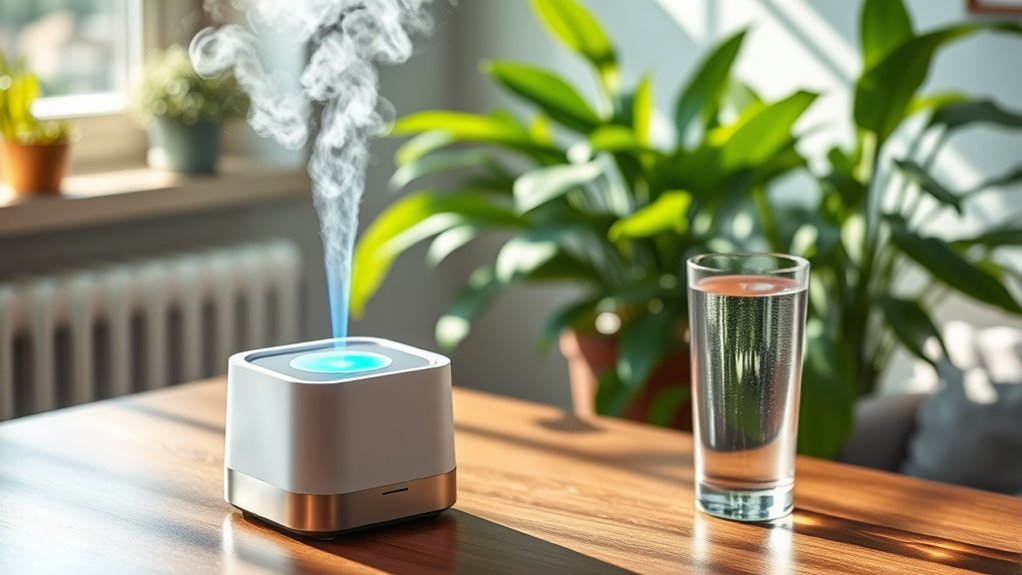
While many people focus on air quality, the health benefits of negative ions shouldn’t be overlooked. These ions can profoundly enhance your well-being.
Research suggests that negative ions may inhibit airborne infections, helping you breathe easier and stay healthier. They can also boost your immune function, making it easier for your body to fend off illnesses. Additionally, exposure to negative ions is linked to reduced stress levels and improved mood, contributing to your overall emotional health. You might even notice better sleep quality, as these ions help regulate your sleep patterns, leading to more restful nights. Furthermore, the use of necessary cookies on websites can enhance user experience by ensuring essential features function properly, similar to how negative ions contribute positively to health. In fact, negative ions are known to improve respiratory health, making it easier to breathe in cleaner air. Moreover, regular veterinary check-ups can support a dog’s overall wellness, much like how negative ions can enhance human health. Understanding the role of sustainable building practices can also help create healthier living environments, emphasizing the importance of clean air in tiny house construction. The latest breakthroughs in machine learning tech are paving the way for innovative air purification technologies that may further enhance the benefits of negative ions.
Drawbacks and Risks of Ozone Production
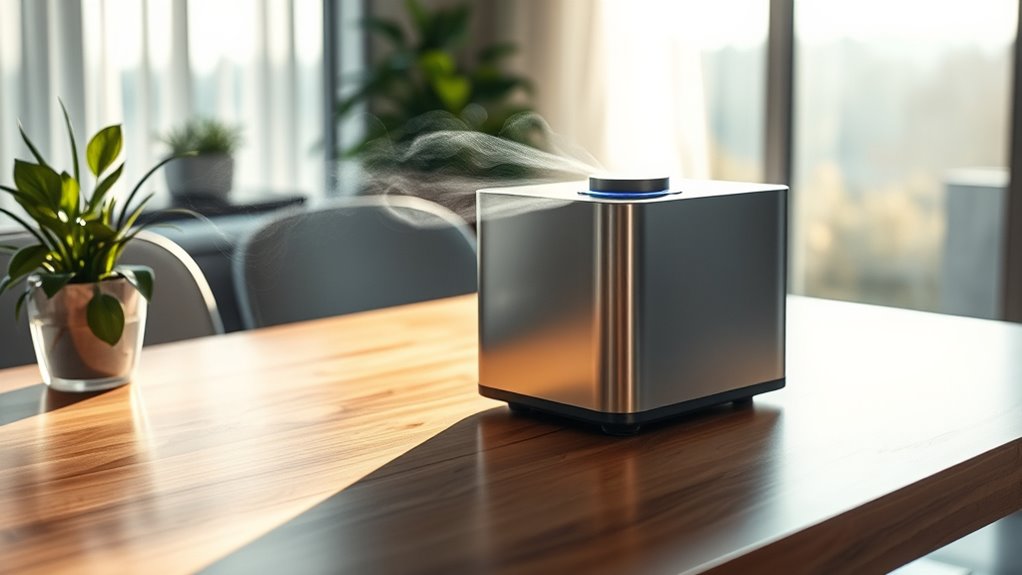
Although ionizers can enhance air quality, they also come with significant drawbacks, particularly due to ozone production.
Ozone is a known lung irritant that can worsen asthma and other respiratory issues. Short-term exposure might cause throat irritation, coughing, and difficulty breathing, while long-term exposure can lead to reduced lung function and a higher risk of respiratory infections. Furthermore, cybersecurity vulnerabilities may arise if smart home devices, including ionizers, are compromised during an attack. Additionally, the use of ionizers can lead to increased customer satisfaction through improved air quality, but the health risks associated with ozone production cannot be overlooked. Understanding the narcissist-borderline dynamic can also offer insights into how emotional instability may affect decision-making regarding air quality solutions. Moreover, the potential for state tax implications on retirement income highlights the importance of comprehensive financial planning when investing in health-related technologies.
Studies show that some ionizers can generate ozone levels exceeding safe limits set by regulatory bodies. The Environmental Protection Agency advises against using ozone-generating air purifiers indoors because of the associated health risks.
While ionizers may reduce certain pollutants, it’s crucial to weigh these benefits against the potential hazards of ozone production before deciding on their use. Additionally, regular filter replacement is essential for maintaining optimal performance and minimizing risks associated with ozone exposure.
Comparing Ionizers and Traditional Air Purifiers

When comparing ionizers and traditional air purifiers, it’s essential to understand how each one works and their effectiveness in removing particles.
Traditional purifiers, with HEPA filters, excel at capturing larger allergens, while ionizers focus on smaller particles but come with ozone emission risks. Additionally, air quality can significantly improve when using devices that combine both technologies for comprehensive air cleaning. This fusion can lead to enhanced energy efficiency in maintaining optimal indoor environments, as these devices work synergistically to reduce pollutant levels. For instance, traditional HEPA filters are particularly effective in removing allergens and pollutants from the air, ensuring a healthier living space. Regular maintenance and cleaning of filters in traditional purifiers are crucial for optimal vacuum cleaner performance metrics and air purification efficiency. Many households also enhance their indoor atmosphere during seasonal celebrations, such as Halloween traditions, by utilizing these air purification solutions.
Knowing these differences can help you choose the best option for your air quality needs.
Mechanism of Action
Understanding the mechanism of action for ionizers and traditional air purifiers reveals key differences in how they tackle airborne pollutants.
Ionization devices generate negative ions that bond with airborne particles, causing them to clump together and settle on surfaces. This process can help reduce air pollution but may not effectively eliminate larger allergens or volatile organic compounds (VOCs).
In contrast, traditional air purifiers use filters, like HEPA, to physically trap 99.97% of particles as small as 0.3 microns, providing thorough cleaning.
However, some ionizers produce ozone, which can irritate the respiratory system and worsen health problems, like asthma. This makes understanding each mechanism essential for choosing the right air purification solution for your needs. Additionally, color accuracy in projectors is vital for ensuring optimal viewing experiences, just as effective air purification is crucial for maintaining a healthy indoor environment.
Particle Removal Efficiency
While both ionizers and traditional air purifiers aim to improve indoor air quality, their particle removal efficiency varies greatly. Here’s a quick comparison of their effectiveness:
- HEPA Filters: Can remove at least 99.97% of particles as small as 0.3 microns, effectively trapping allergens like dust and pollen.
- Ionizers: Generate negative ions that clump smaller particles together, but they struggle with larger allergens, which can trigger asthma.
- PM2.5 Impact: Studies show ionizers may not markedly reduce PM2.5 concentrations, essential for respiratory health.
- Ozone Emission: Unlike traditional purifiers, ionizers may produce ozone, a harmful by-product that can worsen indoor air quality.
Understanding these differences helps you make informed choices about air cleaning devices and their effects on your health.
Ozone Emission Risks
Ozone emissions pose significant risks when comparing ionizers to traditional air purifiers. Ionizers release negative ions that can generate ozone, a known lung irritant that can worsen respiratory conditions like asthma.
The EPA warns against ozone-generating devices, highlighting their potential for harmful health effects, especially in poorly ventilated spaces. In contrast, traditional air purifiers with HEPA filters effectively capture 99.97% of particles without producing ozone.
Although ionizers might reduce some airborne pollutants, they can also elevate levels of harmful volatile organic compounds (VOCs) due to ozone reactions.
The California Air Resources Board emphasizes consumer awareness, urging you to prioritize air quality and safety when choosing an air purification method. Choose wisely to protect your health.
Types of Ionizers: Features and Applications
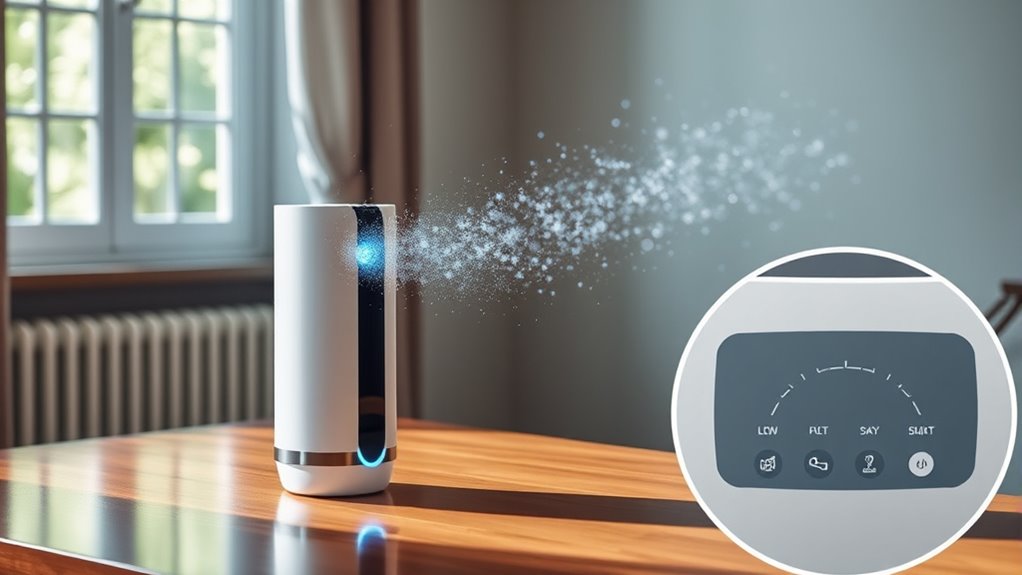
Ionizers play an essential role in enhancing air quality through various technologies tailored to different applications. Here are four types of ionizers you might find useful:
- Bipolar Ionization Devices: They produce both positive and negative ions, improving HVAC systems by enhancing air quality and reducing airborne contaminants.
- Ionizers on Fans: These circulate air while emitting negative ions, improving ventilation for cleaner air throughout the room.
- Air Purifiers with Ionizers: Combining HEPA filters and ionization technology, they capture a broader range of pollutants for better removal.
- Portable Air Cleaners: Designed for specific areas, they target harmful particles and offer flexibility, beneficial for individuals with asthma and allergies.
Choosing the right type can greatly enhance pollutant removal and promote clean air in your environment.
Regulatory Guidelines and Safety Considerations
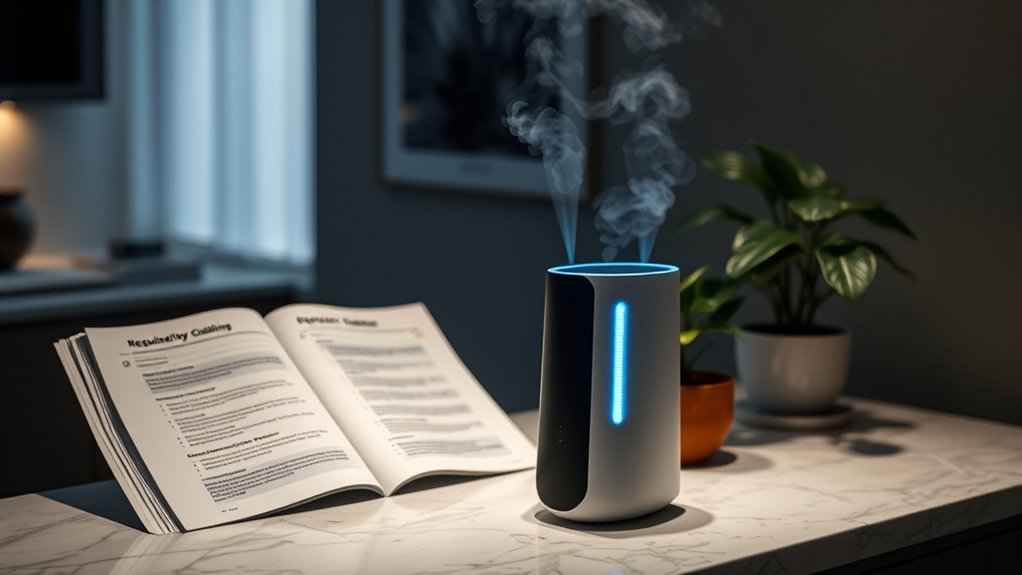
When choosing an ionizer for air purification, it’s essential to contemplate regulatory guidelines and safety factors.
Regulatory bodies like the California Air Resources Board (CARB) have set limits on ozone emissions, indicating that ozone-generating devices aren’t suitable for indoor use due to potential health risks.
The U.S. Environmental Protection Agency (EPA) warns that ozone from air ionizers can worsen asthma and respiratory issues, underscoring the need for consumer awareness about air cleaner safety.
Ozone emitted by air ionizers can exacerbate asthma and respiratory problems, highlighting the importance of understanding air cleaner safety.
While manufacturers of ionizing devices must often meet testing standards, many don’t effectively prove their safety and efficacy.
Instead of relying solely on ionizers, consider evidence-based measures like high-efficiency particle filtration and enhanced ventilation to improve indoor air quality.
Future Research Directions and Recommendations
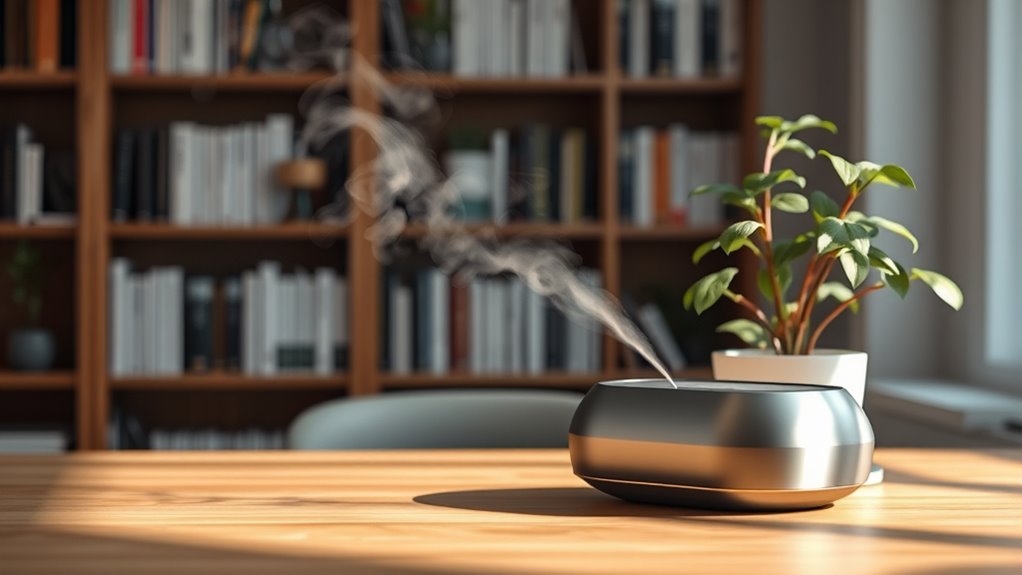
As research continues to evolve, understanding the long-term health effects of ionizers and their ozone emissions becomes increasingly important.
To guide future studies, consider these recommendations:
- Investigate Bipolar Ionization: Examine the effectiveness of commercially available in-duct bipolar ionizers in real-world settings, as lab results may not reflect true performance.
- Focus on Negative Ions: Conduct peer-reviewed studies evaluating the impact of negative ions on respiratory health and mood, addressing existing inconclusive evidence.
- Standardize Testing: Develop standardized protocols for testing air cleaners to guarantee accurate information on air purification capabilities and ozone generation levels.
- Public Awareness: Launch campaigns to educate consumers about the risks and benefits of ionizers versus traditional air purifiers, enhancing overall health and air quality.
Frequently Asked Questions
Why Can’t You Be in a Room With an Ionizer?
You shouldn’t be in a room with an ionizer because it can produce ozone, which irritates your respiratory system.
If you’ve got asthma or other lung issues, this exposure can worsen your condition. Even short-term contact can lead to coughing or throat irritation, making it uncomfortable.
Regulatory bodies advise against using these devices indoors, so it’s best to find safer alternatives for improving air quality without risking your health.
Is It Safe to Sleep With an Ionizer On?
Sleeping with an ionizer on can improve your air quality by reducing airborne particles, potentially benefiting your sleep and respiratory health.
However, be cautious, as some ionizers produce ozone, which can irritate your lungs and worsen conditions like asthma.
To stay safe, make certain your room is well-ventilated and choose an ionizer that emits low ozone levels.
Always prioritize your health and consider consulting with a healthcare professional if you’re unsure.
Which Is Better HEPA or Ionizer Air Purifier?
When it comes to air purifiers, you want to put your best foot forward.
HEPA purifiers clearly outshine ionizers for most people. They capture 99.97% of particles as small as 0.3 microns, making them ideal for allergies.
While ionizers create negative ions, they often produce ozone, which can irritate your lungs.
If you’ve got allergies or respiratory issues, HEPA’s consistent performance is your best bet for cleaner indoor air.
Why Is Ionized Air Good for You?
Ionized air’s good for you because it can enhance your mood and help reduce stress.
Negative ions boost serotonin levels, which might alleviate symptoms of anxiety and depression.
It also improves air quality by clumping airborne particles, making it easier for you to breathe.
Plus, exposure to ionized air may support your immune system and reduce the presence of viruses, creating a fresher, healthier indoor environment overall.
You’ll feel the difference!
Conclusion
So, if you’re looking to breathe cleaner air, you might think an ionizer is your best bet. After all, who wouldn’t want a little extra ozone in their lives? Just remember, while you’re enjoying those negative ions, you might also want to keep an eye on those pesky ozone levels. It’s all about balance, right? In the end, your lungs will thank you for considering both the pros and cons—if they’re still working properly, that is!



